On the use of armored vehicles in the Chernobyl accident zone
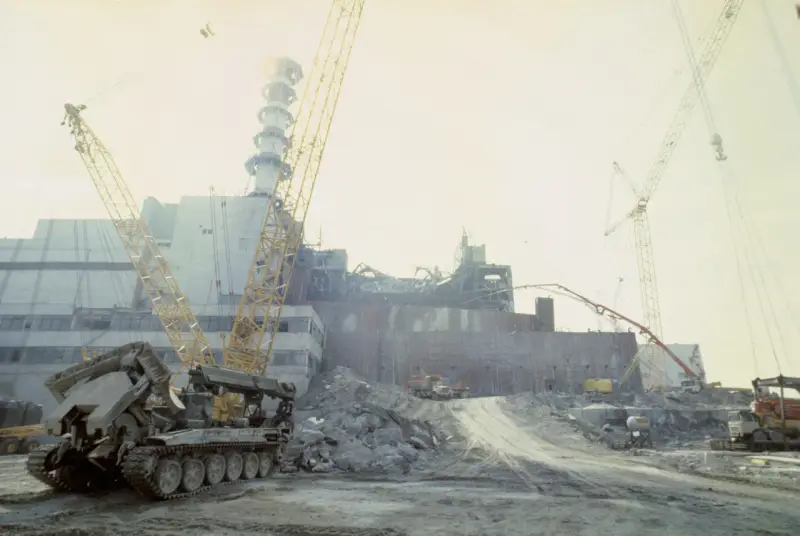
During the liquidation of the world's largest radiation disaster at the Chernobyl nuclear power plant, a large number of various armored vehicles, including engineering ones, were used. However, not all of them were able to pass such a difficult test due to design flaws and outright errors in the organization of their operation in the accident zone. This was written in detail in an article by Yu. P. Kostenko, published in 1989 in the journal “Bulletin of Armored Equipment” - we are publishing it here.
Analysis of the use of armored vehicles in conditions of radiation contamination
The experience of using samples of armored vehicles in the work to eliminate the consequences of the accident at the Chernobyl Nuclear Power Plant (ChNPP) made it possible to identify shortcomings in the design and organization of operation of vehicles under conditions of radiation contamination.
When eliminating the consequences of the Chernobyl accident, IMR-2 tracked engineering clearing vehicles, armored repair and recovery vehicles (BREM) and PTS-2 amphibious transporters, as well as wheeled combat reconnaissance and patrol vehicles BRDM-2РХ and BTR-70 armored personnel carriers were used.
Let us consider issues related to the design of these machines.
Crew protection
Before being sent to the Chernobyl nuclear power plant, almost all of these vehicles were equipped with additional anti-radiation protection (RAP) in the form of lead plates installed inside and outside the vehicle in the crew work area. For BREM, PTS-2 and BTR-70, this measure is justified by the fact that these vehicles are not intended to operate in conditions similar to those that arose at the Chernobyl nuclear power plant.
The IMR-2 and BRDM-2РХ vehicles are designed specifically for work in the destruction zone in areas that have been subjected to nuclear strikes. And the fact that in order to work in a zone of real radiation contamination, it was urgently necessary to equip them with an additional PRZ in the field, speaks of a very simplified approach (both at the stage of developing the TTT, and during the creation of these machines) to assessing the possible effect of γ-radiation on the crew.
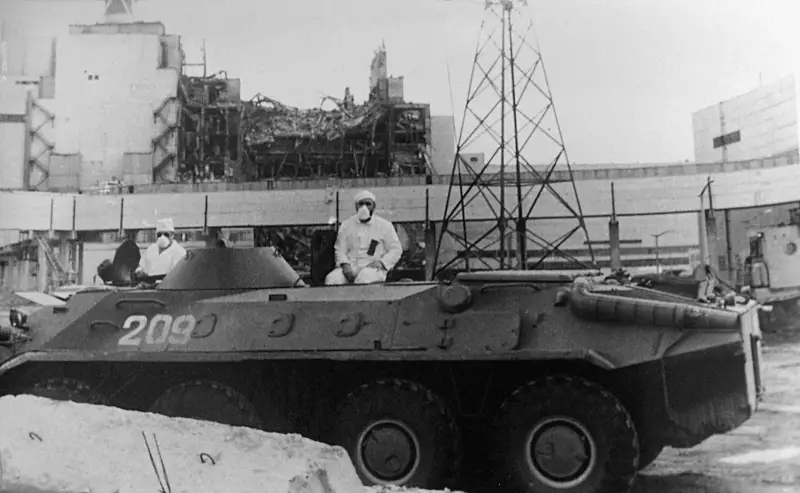
The fundamental difference in the nature of the impact (on personnel and equipment) of conventional weapons in the zone of combat operations and radiation in the zone of radiation contamination is that in the first case the probabilistic laws of destruction apply, and in the second - the total law (all equipment and all personnel located in the contamination zone are exposed to radiation).
In this regard, there is a need to significantly clarify the requirements for protecting the crew and maintaining the operability of vehicles in the radiation contamination zone. If, when designing vehicles, crew protection was calculated taking into account the fact that the source of radiation is contaminated soil and γ-radiation acts from the lower hemisphere, then experience in the Chernobyl nuclear power plant area has shown that radiation sources in the area of destruction are on the ground, on the ruins of buildings, including surviving parts of roofs, and in the forest, tree crowns are such sources. Consequently, the crew must be protected from both the lower and upper hemispheres.
Adaptability of machines to decontamination
Experience has shown that due to the design features of the machines, their decontamination is difficult. The most unsuccessful machine in this regard is the IMR-2. The abundance of open cavities and hard-to-reach places in engineering equipment and outside the machine, where radioactive dust and dirt easily gets in, which then cannot be completely removed, leads to the fact that during decontamination this machine cannot be washed to a level that allows it to be removed from the contaminated area.
The design and installation of the engine air cleaner (AC) requires improvement for all (wheeled and tracked) vehicles that must operate in the radioactive contamination zone. When operating in a contaminated area, the VO turns into a concentrator of radioactive dust, and therefore its design must be such that the time spent on its replacement is minimal. It is advisable to have a disposable filter element. If this is not possible, then effective flushing must be ensured.
We will consider the issues of operation and maintenance of IMR-2 vehicles operating in the Chernobyl Nuclear Power Plant zone using the example of two detachments (each of six of these vehicles) arriving from the Carpathian Military District. The first detachment arrived in the Chernobyl nuclear power plant zone on April 29, the second - on May 6, 1986. The vehicles of both detachments took part in the collection and burial of radioactive products of the accident, in the felling of trees and clearing of contaminated dead forest, in the installation of formwork for a protective biological wall in the area of the fourth block . When installing formwork, in some cases the machines worked in areas where the radiation level reached 360 R/h. At the same time, the radiation level inside the cars reached 15 R/h.
As of June 1, 1986, the operating time of the vehicles in the first squad averaged 150 hours, in the second - 100 hours. After an attempt at decontamination, individual elements of the vehicle design had the following radiation level: air cleaner 5, engine 3, fenders 3,5, caterpillar 2, bottom in the area of the engine-transmission compartment 1, exhaust pipe 1 R/h. At the same time, we note the following: during the specified time, the air purifiers were removed from the cars twice and washed in special baths of increased volume, however, even after washing, their radiation level did not fall below 3,5 R/h; During this time, the oil in the engines was not changed; When washing a car, the lingering radioactive “dirt” could not be washed off.
During the maintenance of these vehicles, three technical service officers who were not directly involved in the work to eliminate the consequences of the accident received radiation doses of 5, 9 and 4 R, respectively.
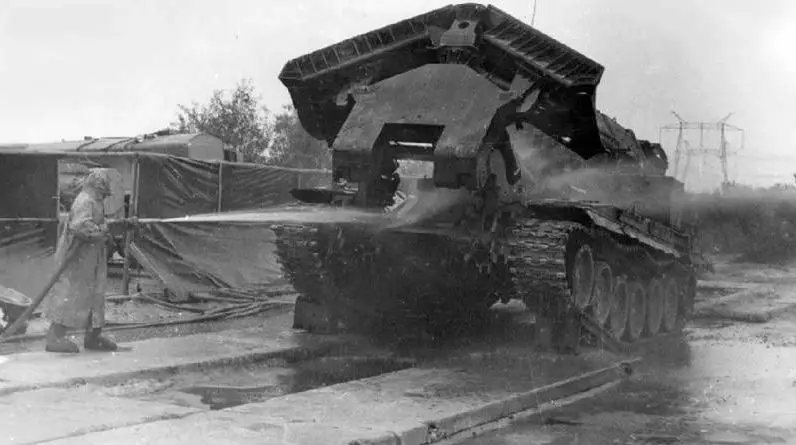
In addition, there were several cases when the radiation level of the tracks increased sharply in vehicles operating in the area of the fourth block. Upon careful monitoring, it turned out that pieces of soil or graphite were pressed between the lugs of the tracks, the radiation level of which reached 150 R/h. To extract them, a special crowbar 2 m long was made, with the help of which these pieces were difficult to remove, and then transported on a stretcher to the place of temporary storage.
From the data presented it follows that when improving machines of the IMR type, it is necessary to ensure the possibility of decontaminating such machines for the purpose of their subsequent operation outside the zone of radiation contamination. At the same time, it is necessary to provide for the possibility of making appropriate changes to the fleet of IMR and IMR-2 vehicles located in the troops.
Special Requirements:
a) Evacuation of the vehicle and crew. While the vehicle is operating in an area with a high level of radiation, if it loses mobility or if there are other malfunctions, the crew is prohibited from exiting the vehicle. The design of the vehicle must provide for the possibility of its automatic coupling with a working vehicle for subsequent towing to an area with a reduced level of radiation.
Considering that when working in extreme conditions, cases of disruption of the normal functioning of the crew are possible, the design of the crew’s workplaces, the location of hatches and various working parts in the area of the hatches must provide the possibility of access from the outside to the incapacitated crew inside the vehicle and their evacuation from the vehicle.
b) Maintaining radiation cleanliness of crew workplaces. The starting positions and maintenance sites for IMR type machines operating in the area of the fourth block of the Chernobyl Nuclear Power Plant were located in places where the radiation level was 0,5-1,5 R/h. Under these conditions, the crew and technical personnel carried a significant amount of radioactive “dirt” into the vehicle on their shoes and uniforms. Such “dirt” with the liquid solution got there during car washing. Moreover, due to poor sealing of the hatches, liquid got inside in such quantities that it caused failures of the electrical equipment of the engine starting system, hydraulic control systems, and television devices. Considering that the design of the equipment of the crew's workplaces practically eliminates the possibility of their decontamination, it is necessary to ensure maximum sealing of the workplaces, to provide for the stowage of replaceable shoes and, possibly, a replaceable set of overalls outside the vehicle.
Everything stated above about IMR-type vehicles can almost entirely be attributed to wheeled and tracked chemical and radiation reconnaissance vehicles, and in terms of decontamination - to tanks, infantry fighting vehicles and armored personnel carriers, since the latter are adapted for combat operations in the zone of radiation and chemical contamination, and their design is not much better (compared to IMR) for decontamination.
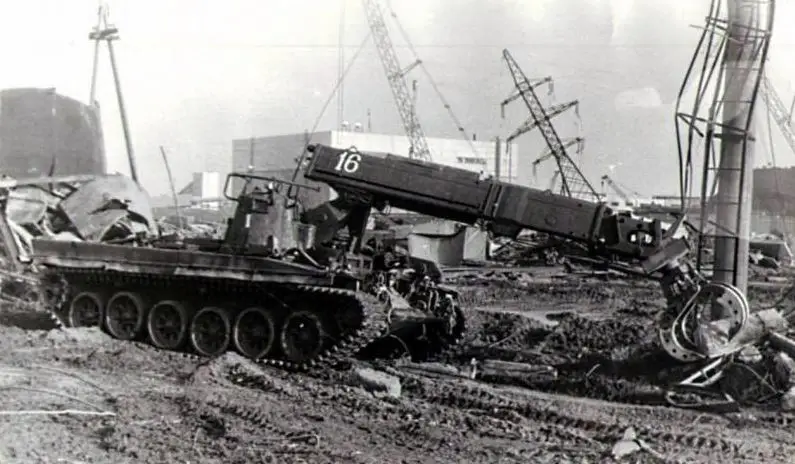
Let us now move on to one of the important issues of machine operation - the frequency of their maintenance. For combat and engineering vehicles, in addition to daily maintenance, two more types of maintenance are provided - depending on the units in which the operating time is expressed - in kilometers or in engine operating hours. Experience has shown that for machines operating in a radiation contamination zone or crossing such a zone, the operating instructions should include a section on the procedure and frequency of machine maintenance, also depending on the level of radiation contamination of its devices and assemblies. At the same time, permissible pollution standards must be linked to the complexity of their maintenance and to permissible standards for safe exposure of people.
Example. Let us assume that the labor intensity of removing the air purifier from the car is 2 man-hours, and the permissible safe radiation dose is 5 R per year. Then the permissible VO pollution rate can be set at 4 R/h, provided that the work is performed by at least two people. In this case, they will spend 1 hour removing the HE. During this hour, each of them will receive a radiation dose from the HE of 4 R. If, in addition, the maintenance site is located in a radiation zone with a level of 0,5 R/h, another 0,5 R each. A total of 4,5 R. As a result, after completing the specified work, both will receive almost an annual dose of radiation and must be removed from the contaminated zone and replaced by others who have not been exposed to radiation.
The example is given for machines operating in a contaminated area. For combat vehicles whose task is only to overcome the contaminated zone, and for engineering vehicles that have completed the task in the contaminated zone, the permissible level of radiation for operating equipment outside the contaminated zone will be determined.
Experience has shown that machines operating in areas of high radiation must be decontaminated daily, and this must be reflected in the appropriate instructions.
Next, we will consider organizational issues.
Composition of the working group of machines
On the territory of the Chernobyl Nuclear Power Plant in May-June 1986, the radiation level throughout the entire industrial site was 0,5 R/h. In the area of the machine room and on the side of the fourth block there were zones with levels from 100 to 500 R/h. In the immediate vicinity of the rubble, the radiation level exceeded 1000 R/h.
Experience has shown that in order to organize a wide range of work on the territory of the Chernobyl Nuclear Power Plant, vehicles with different levels of crew protection and with various engineering equipment are needed.
By the time work began to decontaminate the area from the turbine hall side, the radiation level from block No. 1 to block No. 4 was as follows: in the area of blocks No. 1 and 2 - from 0,5 to 5 R/h, in the area of block No. 3 - from 5 up to 17 R/h, in the area of block No. 4 (measurements were carried out at 11 points every 20-25 m) at point No. 1 it reached 17 R/h, No. 2 - 40, No. 3 - 117, No. 4 - 290, No. 5 - 380, No. 6 - 520, No. 7 - 430, No. 8 - 400, No. 9 - 325, No. 10 - 190 and No. 11 - 230 R/h. In the zone with a level from 0,5 to 5 R/h, radio-controlled bulldozers worked; in the zone with a level from 5 to 117 R/h (point No. 3), IMR-2 machines, equipped with additional protection that weakened radiation by 100-120 times, worked , in the zone from point No. 3 to point No. 11, machines of the IMR type were operated with protection that provided a 500-1000-fold attenuation of radiation. Machines of the IMR type were under the jurisdiction of the engineering troops, radio-controlled ones were under the jurisdiction of the USSR Ministry of Energy. When planning and carrying out work, this caused additional difficulties and extremely undesirable disruptions in such conditions.
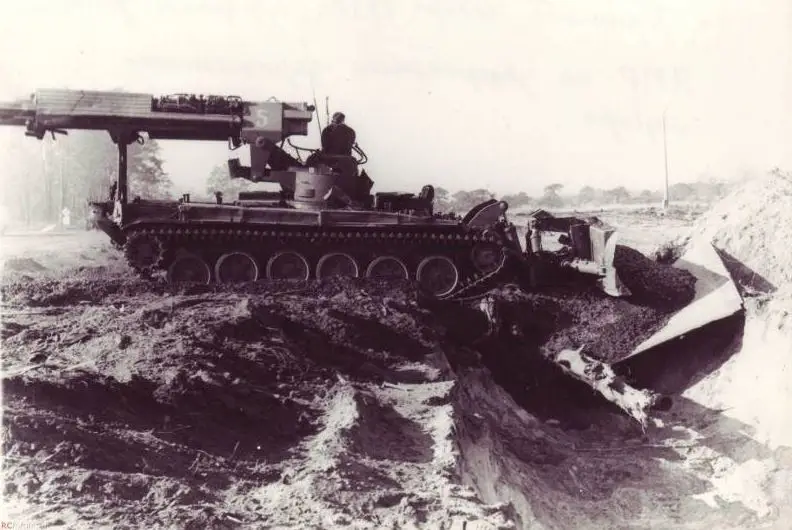
Events at the Chernobyl Nuclear Power Plant showed that for coordinated teamwork of different groups of machines in contaminated zones with different levels of radiation, it is necessary to develop and strictly monitor compliance with daily hourly work schedules for each group of machines, determine the work zones of each group, the groups’ movement routes, the order of delivery and evacuation of containers with radioactive waste, as well as the procedure for technical maintenance of machines and the place where it is carried out. In order to avoid unnecessary exposure of people, after the approval of the specified schedule, it is necessary to determine the personnel of the work participants, taking into account the total radiation doses they have already received and the estimated doses that they will receive when performing the work provided for by the schedule.
Thus, the working group must include all types of vehicles necessary to complete the assigned task, and the group must have a single command. In this case, it is possible to comprehensively plan work in the contaminated area and provide it with personnel, taking into account the effects of radiation on the human body.
Insufficient clarity in the organization of work in the Chernobyl nuclear power plant zone led to the fact that in a number of cases, personnel received radiation doses 1,5-2 times higher than the established norms.
Organization of technical maintenance (TO) of machines
In the ground forces, daily maintenance of vehicles is usually carried out by the crew.
Crews of complex machines consist of at least three people. With three crew members, vehicle maintenance in a combat situation can only be carried out by only two of them, since the vehicle commander, due to the additional workload, does not have time for this. In this regard, the total time for servicing the machine increases.
Even more effort and time are required for maintenance of IMR-2 vehicles, since their crew consists of two people.
In Chernobyl, for the first time, IMR type vehicles with a 1000-fold increased level of protection, equipped with television control systems, a manipulator with an electro-hydraulic drive and special air purification systems, appeared in the engineering troops. The crew of the vehicle consisted of a commander-operator and a driver. The duties of the operator in these vehicles were performed by an officer, and the duties of the driver by a sergeant (class specialist of the second year of service). The crews underwent special training at industrial enterprises. It took about 10 days to prepare an operator and driver specifically for working in a new machine, including “putting together” a crew, and when working in the Chernobyl nuclear power plant zone, this crew received maximum permissible radiation doses during 12-15 working days in a zone of increased radiation. and was replaced with a new one. Obviously, replacing the crew during an operation is undesirable. In order to make the most efficient use of the crew for work in an area of increased radiation, they must be exempted from participation in vehicle maintenance work. This should be done by a group of specialists with such knowledge and skills that the crew cannot acquire during military service.
At the Chernobyl Nuclear Power Plant, industry representatives constantly participated in the daily maintenance of machines and in eliminating any failures that occurred.
Currently, research and development work is being carried out to increase the level of protection of the IMR-2 machine, to improve its engineering equipment (increasing its versatility). As a result of this work, IMR-2 will be used in areas with higher radiation levels. Consequently, the physical and emotional stress on the crew will increase, and the volume and complexity of vehicle maintenance will increase. Therefore, in order to use the crew with maximum efficiency only for work in an area of high radiation, it is necessary to free them from daily maintenance work, introducing special technical personnel into the staff of the units of such vehicles.
In conclusion, let's look at the questions remote control of machines.
Events at the Chernobyl Nuclear Power Plant led to increased efforts to introduce remote control of engineering machines and complexes. Developed by industry with the participation of engineering troops. Domestic developments and samples purchased abroad were used. Control systems were tested from the simplest (with observation within the operator's line of sight) to the most complex (with television surveillance systems providing a stereoscope image). But under the conditions of the Chernobyl nuclear power plant, significant positive results were not achieved.
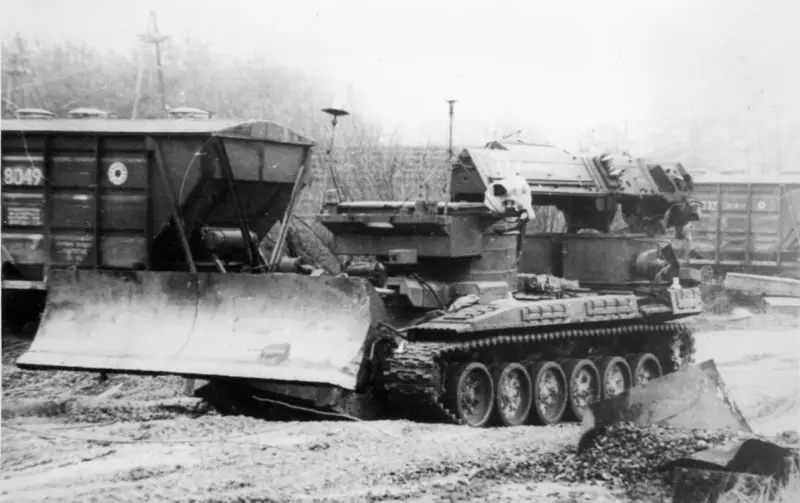
It is worth highlighting one robotic complex based on two machines of the IMR type: one is a controlled robotic machine (without a crew), the second is a control machine. The complex meets the requirements of the engineering troops, and its industrial development has now begun. It is worth noting that all comments on the experience of working at the Chernobyl nuclear power plant that relate to conventional engineering machines can also be applied to the machines included in the complex being developed. At the same time, certain issues become even more important. It is necessary to especially reliably protect radio-television equipment and electrical automation devices from moisture, and reduce to a minimum the time spent on inspection operations and daily maintenance. The designs of the equipment installed on them must ensure the possibility of their decontamination to the level of residual radiation, allowing these machines to be removed from the contaminated zone and used repeatedly.
The design of the robotic complex that operated in the Chernobyl Nuclear Power Plant zone did not meet these requirements, as a result of which numerous failures occurred during the work, and upon completion it turned out to be impossible to reduce radiation to an acceptable level.
Hack and predictor Aviator
When developing new and improving production vehicles intended for work or combat operations in the radiation contamination zone, it is recommended to take into account the results of an analysis of the use of armored vehicles in eliminating the consequences of the Chernobyl nuclear power plant accident.
Source:
Kostenko, Yu. P. Analysis of the use of armored vehicles in conditions of radiation contamination / Yu. P. Kostenko // Bulletin of armored vehicles. - 1989. - No. 1.
Information